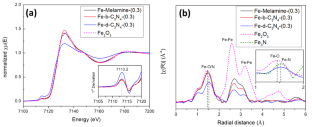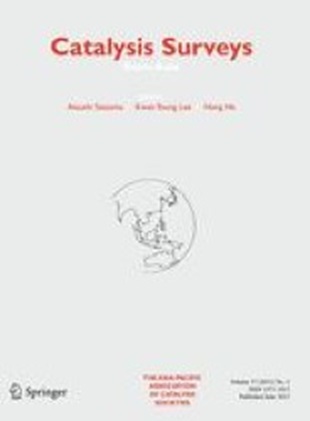Conversion of CO2 to Light Hydrocarbons by Using FeCx Catalysts Derived from Iron Nitrate Co-pyrolyzing with Melamine, Bulk g-C3N4, or Defective g-C3N4
IF 2.1
4区 化学
Q3 CHEMISTRY, PHYSICAL
引用次数: 0
Abstract
FeCx catalysts (Fe-CN-Py) were synthesized by co-pyrolyzing the mixture of iron nitrate and a CN source (melamine, bulk g-C3N4 (b-C3N4), or defective g-C3N4 (d-C3N4)). The physicochemical properties of Fe-CN-Py catalysts and their activities of CO2 hydrogenation to light hydrocarbon (C2-C6) were analyzed. The results indicated that Fe-d-C3N4-(0.3)-Py is the most promising with the highest CO2 conversion (47.2%), olefin yield (10.8%), and olefin space-time yield (STY = 4.5 µmol olefin/s/gFe). The promising activity of Fe-d-C3N4-(0.3)-Py was attributed to its high concentration of surface FeCx. The correlation between surface FeCx and the STY of hydrocarbons and olefins was established.

使用硝酸铁与三聚氰胺、散装g-C3N4或缺陷g-C3N4共热解所得的FeCx催化剂将CO2转化为轻烃
将硝酸铁与CN源(三聚氰胺、本体g-C3N4 (b-C3N4)或缺陷g-C3N4 (d-C3N4))共热解制备FeCx催化剂Fe-CN-Py。分析了Fe-CN-Py催化剂的物理化学性质及其催化CO2加氢制轻烃(C2-C6)的活性。结果表明,Fe-d-C3N4-(0.3)- py最有前途,具有最高的CO2转化率(47.2%)、烯烃收率(10.8%)和烯烃时空收率(STY = 4.5µmol olefin/s/gFe)。Fe-d-C3N4-(0.3)- py具有良好的活性是由于其表面含有高浓度的FeCx。建立了表面fex与烃类和烯烃stx的相关性。
本文章由计算机程序翻译,如有差异,请以英文原文为准。
求助全文
约1分钟内获得全文
求助全文
来源期刊

Catalysis Surveys from Asia
化学-物理化学
CiteScore
4.80
自引率
0.00%
发文量
29
审稿时长
>12 weeks
期刊介绍:
Early dissemination of important findings from Asia which may lead to new concepts in catalyst design is the main aim of this journal. Rapid, invited, short reviews and perspectives from academia and industry will constitute the major part of Catalysis Surveys from Asia . Surveys of recent progress and activities in catalytic science and technology and related areas in Asia will be covered regularly as well. We would appreciate critical comments from colleagues throughout the world about articles in Catalysis Surveys from Asia . If requested and thought appropriate, the comments will be included in the journal. We will be very happy if this journal stimulates global communication between scientists and engineers in the world of catalysis.
 求助内容:
求助内容: 应助结果提醒方式:
应助结果提醒方式:


